Trips & Vacations - The Holy Land 2013
Betsy had been wanting to go to the Holy Land for several years, and in 2013, took the plunge. Bruce and Betsy had wanted to do it together, but it was just a bit too expensive for both.
The chronology below provides a day-by-day summary of events, and only hits the "high points." Jay Patterson, a friend of theirs, took over a thousand photos during the trip, and a few are included below.
Sunday, July 7, was the day most of of the group was in transit. Since the overnight flight did not afford most of the travelers the kind of rest they are used to, they took it easy this first night, staying the night at the beautiful Seasons Hotel in Natanya, thirty miles up the coast to the north.
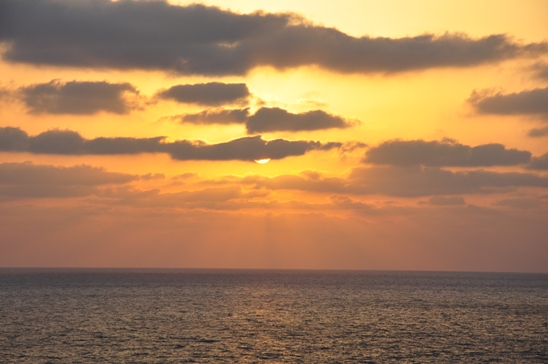
The resort is situated on the shore Mediterranean Sea.
Day 2 - Mediterranean Coast to the Sea of Galilee
After their first night in modern Natanya, they were off and running on a very busy day took them across northern Israel and through centuries of history.
CAESAREA
Their first stop was in Caesarea. Named for the emperor, this was a "Rome away from Rome" set up in Caesar's honor. As such, Caesarea was designed and outfitted as a Roman outpost in the East. The city was presented as a gift by Caesar Augustus to Herod the Great in AD 30. Herod built Sebaste Harbor there, which rivaled any harbor on the Mediterranean. There are a number of great archeological features to see at Caesarea (sometimes called Caesarea Maritima, "on the sea," to distinguish it from Caesarea Philippi up north). One feature is an aqueduct that dates to the first century, which was inscribed with a dedication to Pontius Pilate, no less. Also, there is a wonderfully-preserved Roman amphitheater, as seen in the photo below. You can read in Acts 12:20-24 about how Herod Agrippa died in Caesarea, perhaps in this very amphitheater. Some scholars suggest that the "throne" to which Acts refers is the central section of the amphitheater that was carved out for the king.
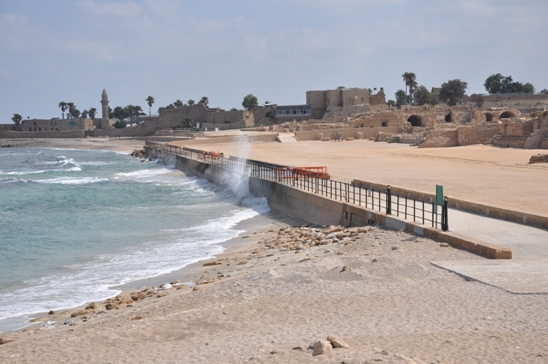
MOUNT CARMEL
After Caesarea, they continued north to Mount Carmel which overlooks the Valley of Jezreel, also known as the Valley of Armageddon. This is one of the most beautiful vantage points in the country. They visited the Muhkakra convent, commemorating the place where Elijah called down fire upon the priests of Baal.
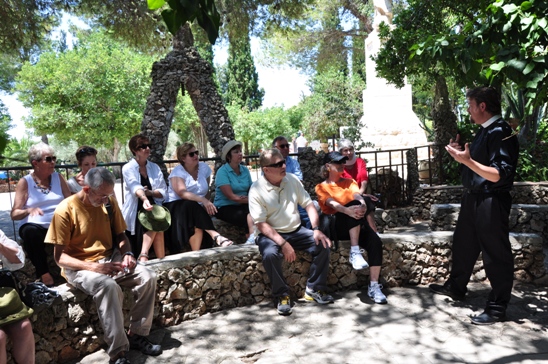
NAZARETH
Next, they were off to Jesus' home town of Nazareth. The main attraction here was the Basilica of the Annunciation where the Angel Gabriel announced to the Blessed Virgin Mary that she had been selected to be the mother of God, and where she said those most amazing words: "Let it be to me according to thy word." The world hasn't been the same since.
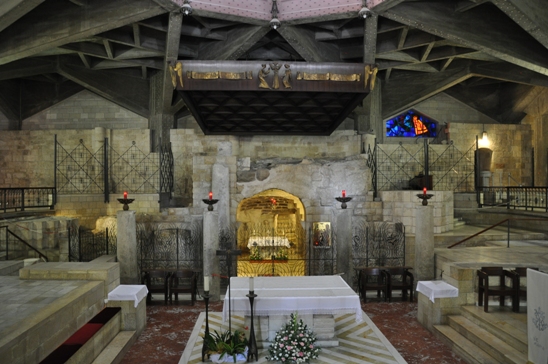
CANA
From Nazareth, they went on to visit nearby Cana of Galilee. Some chose to renew their wedding vows in the city where Jesus turned water into wine. There, they also had an opportunity to see the old, impressive stone water jars.
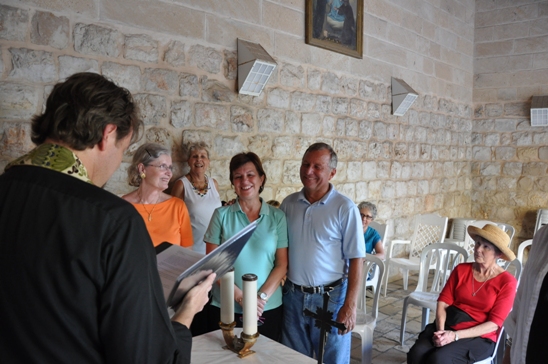
The travels for the first day ended at the Restal Hotel in Tiberias, on the western shore of the Sea of Galilee.
CAPERNAUM
When Jesus left Nazareth, Capernaum became His home base for ministry (see Matthew 4:13). Capernaum was also the hometown of brothers Peter and Andrew, and brothers James and John, and the center of their families' fishing business. One wonderful feature of the archeological excavation at Capernaum is a synagogue that dates to the fourth century, AD. Though this is not the synagogue in which Jesus would have taught, it is built on the same site as the first century synagogue. (See Mark 1:21, "They went to Capernaum, and when the Sabbath came, Jesus went into the synagogue and began to teach.") It was also at the Capernaum synagogue that Jesus shocked his contemporaries by saying he was the True Bread which has come down from heaven. (John 6)
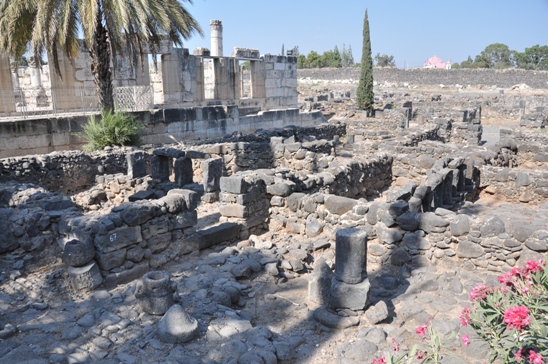
THE MOUNT OF BEATITUDES
Nearby, they went to see the Mount of Beatitudes and the beautiful outdoor chapels at the Church of the Beatitudes. It was very moving to hear and reflect on Jesus' words, "Blessed are the poor in spirit, for theirs is the kingdom of God" in the very place where they were first uttered.
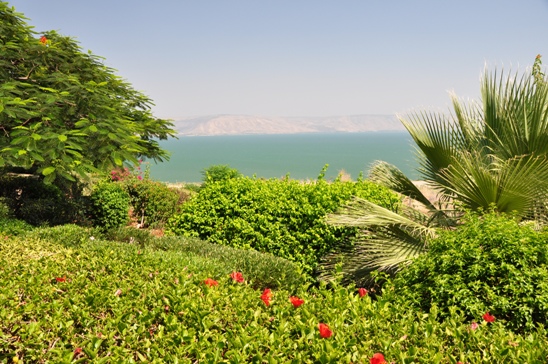
TABGHA
Next, they went to Tabgha, the traditional site of the multiplication of the loaves and the fishes, and also the town where it is believed Jesus had his post-resurrection conversation with Peter, giving the thrice-denying Peter the threefold chance to declare his love for Christ. This is also where Jesus gave the gentle command to the Apostle, "Feed my sheep." (John 21:1-19)
CAESAREA PHILIPPI
From Tabgha the group headed way, way north to Caesarea Philippi and the headwaters of the Jordan River. This was a truly fascinating place. Caesarea Philippi was is a city on the outermost edge of the Israel of Jesus' day. As such, it was a place where Greek paganism and Jewish monotheism co-mingled. The photo on the right is taken in the city center where niches remain in the mountains, in which were situated statues of the nature god Pan and other pagan deities. What's fascinating is that this pagan city, a religious marketplace of sorts, is where Jesus took his disciples to ask the provocative question, "Who do you say that I am." And then, of course, Peter's explosive answer is uttered: "You are the Christ, the Son of the living God." (See Matthew 16:13-20.)
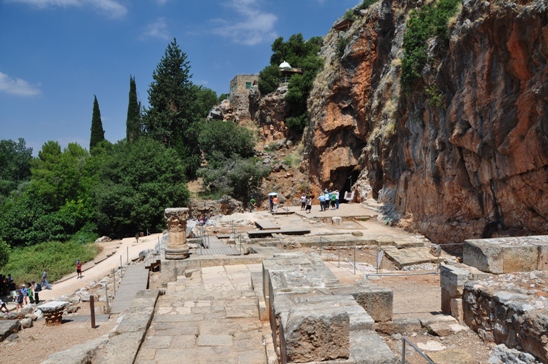
That night the group went back to the Restal Hotel on the Sea of Galilee.
On this day, they crossed the border into the nation of Jordan on the west side of the Jordan River. It wouldn't have been exactly the same for Jesus, though. In the 1st century the whole area was part of Roman empire. The Jordan River valley and the territory east of the Jordan was known as the Decapolis (Greek for "Ten Cities") since in this land there were ten, major, Roman-style cities that extended the Greco-Roman culture throughout the Near East. Sometimes Jesus is described as a bumpkin from backwater Nazareth, assuming he spoke only Aramaic and knew little about the wider world. But in Matthew 4:25 we read, "And great crowds followed him from Galilee and the Decapolis, and from Jerusalem and Judea, and from beyond the Jordan." We see here that Jesus moved in and among a variety of world cultures. The Decapolis was a territory known to him, and a region in which he was known.
MOUNT TABOR
The first stop was Mount Tabor, located a little southwest of Tiberius. It is also called the Mount of Transfiguration, since Christians have identified this as the hill upon which Jesus had his "mountain top experience" with Moses and Elijah and the voice of the Father proclaiming, "This is my beloved son. Listen to him." (Luke 9:28-36)
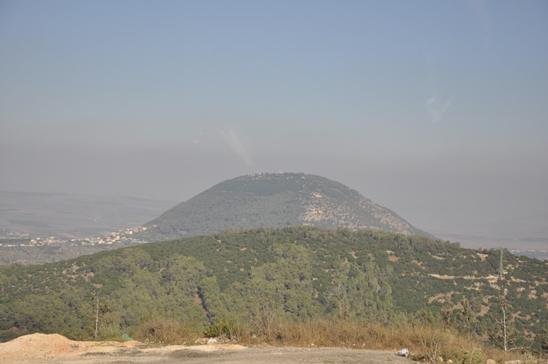
THE VALLEY OF ARMAGEDDON
Between Mount Tabor on the east and the ancient city of Megiddo on the west is the Jezreel Valley. In the mid 14th century BC, this was the site of the epic battle between the forces of Deborah and Barak on one hand, and King Jabin's Canaanite army, led by the commander Sisera, on the other. (Judges 4) In 2 Kings 23:29 another decisive battle is described, Megiddo being the place where King Josiah is slain by the forces of Pharaoh.
What does all this have to do with Armageddon? The cryptic name Armageddon, found only in Revelation 16:16, is Hebrew for "Mount Megiddo." Since Megiddo was a city on a plain, not a mountain, most interpret this as "symbolic geography": Megiddo and the Valley of Jezreel (pictured on the right) represent a global combat zone, a foreshadowing of the final, cosmic battle between Christ and the forces of Satan.
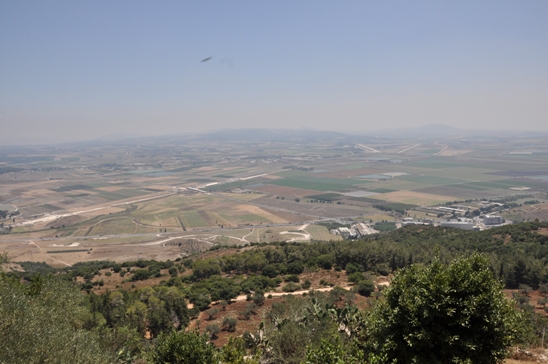
JERASH
Moving further into Jordan they ended the day exploring Jerash. In the first century, this Decapolis city was known as Gerasa. Because of the magnificent excavation at this site, some refer to Jerash as the "Pompeii of the Middle East"--referring to its size and level of preservation, not that Jerash was ever buried by a volcano. Jerash is considered one of the most important and best preserved Roman cities in the Near East.
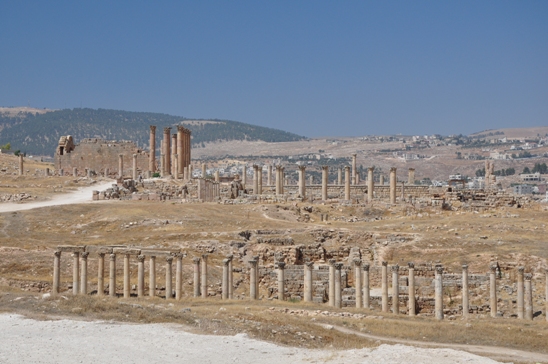
After exploring Jerash, they traveled to the Holiday Inn on the Jordanian shore of the Dead Sea.
Day 5 - John the Baptist, Moses, and a Map of Jerusalem
THE SITE OF JESUS' BAPTISM
The next day, they went to the Jordan River and the place where Jesus was believed baptized. In St. John's account of Jesus' baptism it says, "These things took place in Bethany across the Jordan, where John was baptizing." (John 1:28) The traditional site for Jesus' baptism is indeed "across the Jordan" on the Jordanian side of the river.
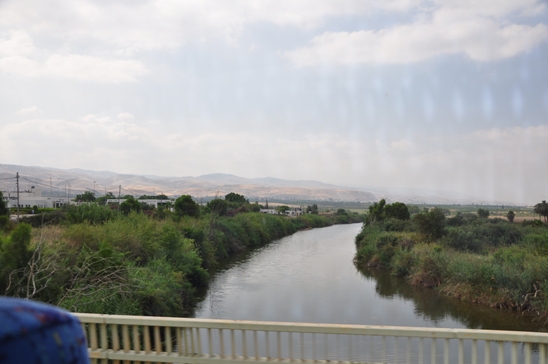
There, many in the group reaffirmed their baptismal vows, and some brought back a bottle of water from the Jordan River blessed by Fr. Houk. The site of Jesus' baptism has a nice website here.
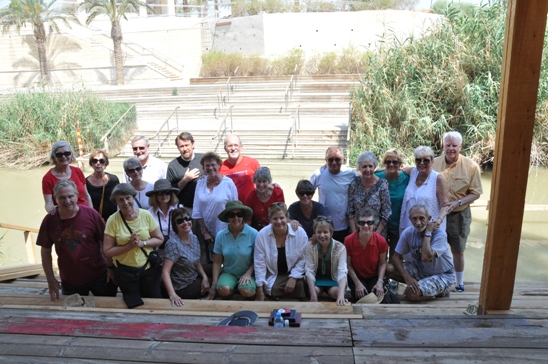
MOUNT NEBO
Next the group traveled south to Mt. Nebo. This is where the journey ended for Moses, since God did not allow him to enter the promised land because of the way he struck the rock in the wilderness. (Even prophets have a bad day.) Mt. Nebo is mentioned in Deuteronomy 32:48-34:12, where we hear the last words of Moses to the people of Israel. He had brought them through the forty years of the Exodus, and now they were about to enter the promised Land without him. But from Mt. Nebo, Moses and the Hebrews could see the land God had promised them. From the summit of Mt. Nebo, the city of Jericho is usually visible, as is Jerusalem on a clear day.
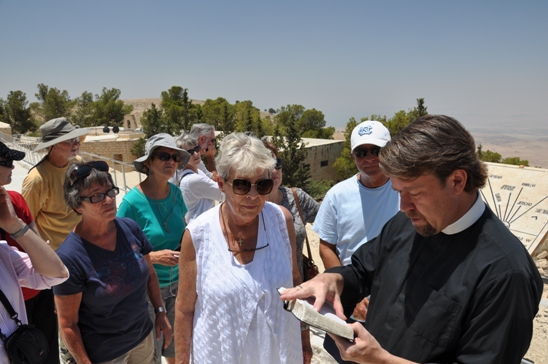
ST. GEORGE'S, MADABA
Not far from Mt. Nebo is the city of Madaba, where the group had a tasty, authentic Jordanian lunch. After lunch, they walked down the street to the Greek Orthodox Basilica of St. George. This was a real treat in that it's not a holy site, per se, but on the floor of the nave in this ancient church is a mosaic that dates back to the 6th century. The map is made with over two million pieces of colored stone and depicts the towns and topography of Palestine. It is the earliest existing representation of Byzantine Jerusalem. In the mosaic there are important details of the city's 6th-century landmarks, with the cardo and the Holy Sepulchre clearly visible. This map has greatly contributed to what scholars know about Jerusalem after its destruction and rebuilding in 70 AD.
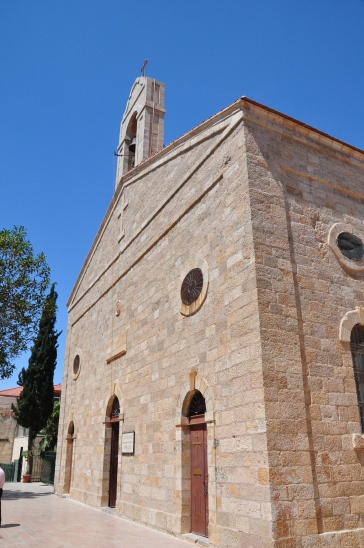
Petra means "rock" in Greek, and Petra is a city that was carved out of the rock around the 6th century BC as the capital of the Nabataeans. The Nabataeans were the ancient people of southern Jordan, Canaan, and the northern part of Arabia They were a nomadic people that established a number of oasis settlements in the Near East. The city lies on the slope of Mount Hor in a basin among the mountains which form the eastern flank of the Wadi Arabah, the large valley running from the Dead Sea down to the Gulf of Aqaba. The site remained unknown to the Western world until 1812, when it was explored by the Swiss traveler and orientalist Johann Ludwig Burckhardt. It was described as "a rose-red city half as old as time" in a Newdigate Prize-winning poem by John William Burgon.
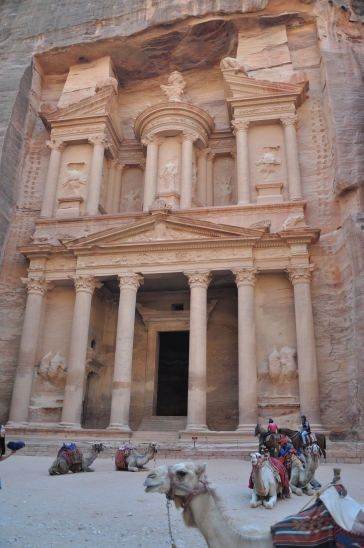
Petra is an amazing, marvelous place. It is a down-hill walk into the ancient city and an uphill walk out. About half-way down the valley, they came to the Treasury, the most photographed place in Petra. They continued walking down the rest of the way to the end of the city. They then took a camel ride back up to the Treasury. That night, they had dinner and stayed overnight at the Amra Palace at Petra.
On Day Seven, the group left the Nation of Jordan after the long bus-ride up from Petra. They crossed the Jordan River at the Albany bridge and reentered Israel.
CROSSING THE JORDAN
This point is also where Joshua and the Israelites crossed the Jordan River into the Promised Land after their forty long years of wandering in the wilderness. (Joshua 3.)
JERICHO
Next, like the aforementioned Israelites did after crossing the Jordan, the group traveled to Jericho, though there were no longer walls for them to march around. (Joshua 6) Some walls could be seen at an archaeological site, and they were able to see layer after layer of the civilizations that called Jericho "home." It is the oldest inhabited city in the world, with human occupation dating back to 9,000 BC. Excavations show that Jericho has been a walled city since approx 3,200 BC, flourished during era of the patriarchs (c. 2,000 - 1,600 BC).
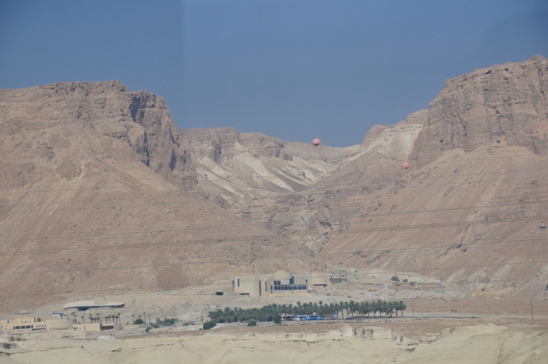
THE JUDEAN WILDERNESS
From Jericho, looking westward, the group could see the Mount of Temptation on the edge of the Judean Wilderness. There is a monastery there that commemorates the place where Jesus fasted and prayed and was tempted by Satan for 40 days. After seeing the rocky terrain of the Judean Wilderness, the group understood why the diabolical tempter suggested Jesus turn the stones into bread since there are plenty to be found and not much else. At the end of the day, the group checked in to the Intercontinental Hotel for a good night's rest and to prepare for a very busy and active day to follow.
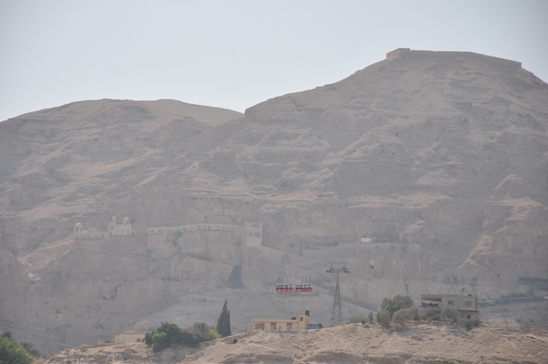
DAY 8: Masada, Ein Gedi, Qumran and up to Jerusalem
They were out in the wilderness for one more day, and then it was up to the Holy City.
MASADA
Masada was a fascinating place! It was originally built as a summer residence for Herod the Great. Later it was used by revolutionary Jews to make their last stand against the Roman Empire in 135 AD. To read about the Roman siege of Masada at the time of the revolt, you can go to this article by Wikipedia. But you also have time to get on Netflix and rent the 1980 made-for-TV miniseries starring Peter O'Toole. Also, there are some majestic shots of Masada, and the panorama seen from atop, here.
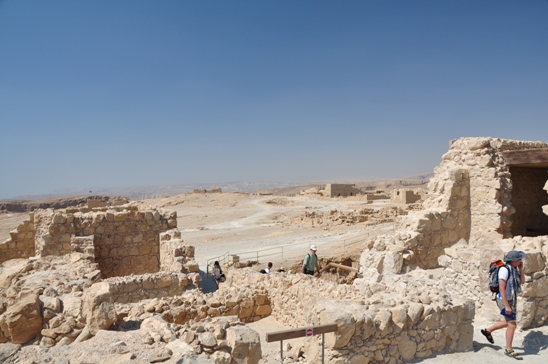
EIN GEDI
Next, the group headed south to the oasis of Ein Gedi. This is where King Saul pursued David, and where David found refuge in a cave. (1 Samuel 24.) You can see the waterfall at this Ein Gedi page.
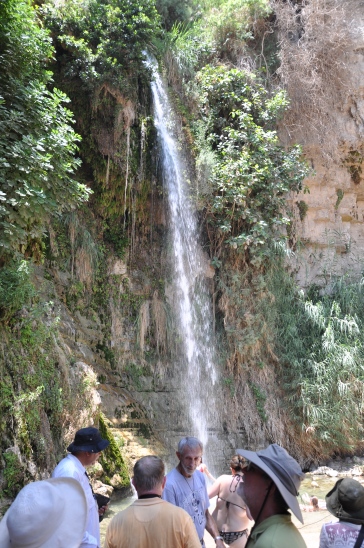
QUMRAN
Their first stop of Day Eight was the excavation at Qumran where the group learned about the Essenes, the community that produced the Dead Sea Scrolls. The great Jewish historian Josephus, writing toward the end of the first century, describes the Essenes, Pharisees, and Sadducees as the three major sects within Judaism in his day. He goes on to detail the Essenes' voluntary celibacy and poverty, their observation of ritual baths every morning, and their commitment to communal living. The Essenes may have gathered here in the Judean wilderness, on the northwest corner of the Dead Sea, believing that the end of the world was at hand.
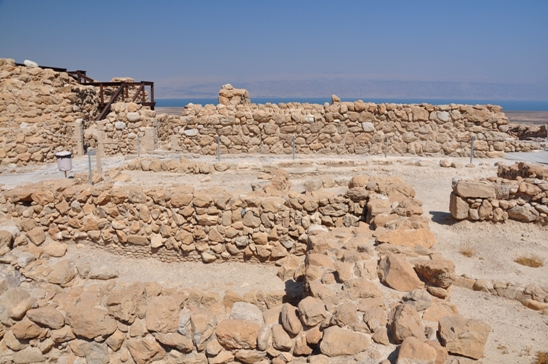
JERUSALEM
"And taking the twelve, Jesus said to them, 'Behold, we are going up to Jerusalem, and everything that is written of the Son of man by the prophets will be accomplished.'" (St. Luke 18:31) In the Bible, one always goes "up" to Jerusalem, even if one is heading south, as Jesus was in the passage from Luke. This is because the drive north from Masada to Jericho, and then east to Jerusalem is up. But whatever direction travel, you will always be going up, up, up to the peak of the Judean hill country, where the Holy City sits some 2,700 feet above sea level. With Jericho being one of the lowest cities on earth, they experienced a rather steep ascent.
When Jewish pilgrims journeyed to Jerusalem, usually once a year at Passover, they would sing psalms. These pilgrimage psalms are known as the "Psalms of Ascent," referring to the steep climb the pilgrims were making to Jerusalem. The Psalms of Ascent include Psalm 120 through Psalm 134, and the group read a few as they climbed, albeit in the cool and comfort of an air conditioned tour bus.
After the ascent from Jericho, the group arrived at the The Golden Walls Hotel in Jerusalem, their home for the next three nights.
DAY 9: The Old City of Jerusalem
CHURCH OF THE HOLY SEPULCHER
The went early in the morning. The Church of the Holy Sepulcher, known as the Church of the Resurrection, is a church in the Old City of Jerusalem that is the holiest Christian site in the world. It stands on a site that is believed to encompass both Golgotha, or Calvary, where Jesus was crucified, and the tomb (sepulcher) where he was buried. The Church of the Holy Sepulcher has been an important pilgrimage destination since the 4th century.
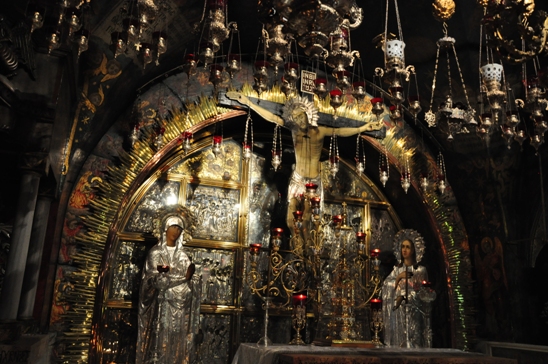
CHURCH OF THE ASCENSION
The Chapel of the Ascension is a shrine located on the Mount of Olives, in the At-Tur district of Jerusalem. Part of a larger complex consisting first of a Christian church and monastery, then an Islamic mosque, it is located on a site the faithful traditionally believe to be the earthly spot where Jesus ascended into Heaven forty days after his resurrection. It houses a slab of stone believed to contain one of his footprints.
CHURCH OF THE PATER NOSTER
Named for the "Our Father" prayer (Latin: Pater Noster), the Church of the Pater Noster stands on the traditional site in Jerusalem where Jesus taught his disciples the Lord's Prayer. Emperor Constantine built a church over a cave here in 4th century, and this has been partially reconstructed. Plaques in the cloister bear the Lord's Prayer in 62 different languages.
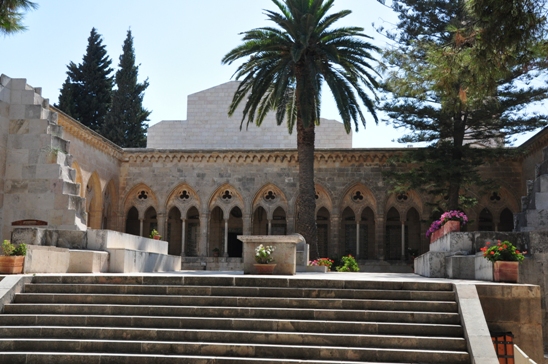
MOUNT OF OLIVES
The Mount of Olives is a mountain ridge east of and adjacent to the Jerusalem's Old City. It is named for the olive groves that once covered its slopes. The southern part of the Mount was the necropolis of the ancient Judean kingdom. The Mount is central to Jewish tradition since it has been used as a Jewish cemetery for over 3,000 years and holds approximately 150,000 graves. Several key events in the life of Jesus as related in the Gospels took place on the Mount of Olives, and in the Book of Acts it is described as the place from which Jesus ascended to heaven. Because of its association with both Jesus and Mary, the Mount has been a site of Christian worship since ancient times and is today a major site of Christian pilgrimage for Orthodox, Catholic and Protestant Christians.
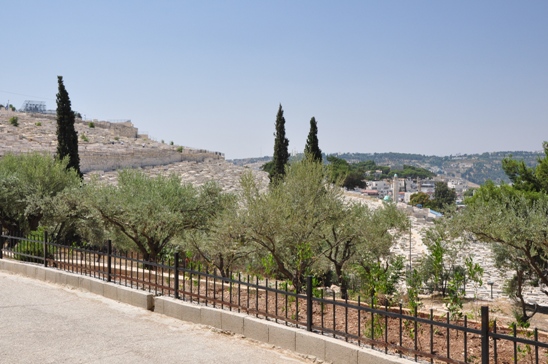
GARDEN OF GETHSEMANE
Gethsemane, which means oil press, is a garden at the foot of the Mount of Olives in Jerusalem most famous as the place where, according to the gospels, Jesus and his disciples are said to have prayed the night of Jesus' betrayal, arrest, trial, sentencing and crucifixion.
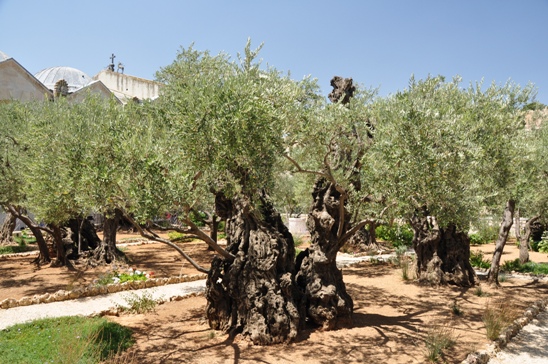
CHURCH OF THE AGONY
The Basilica of the Agony, also known as the Church of All Nations, is a Roman Catholic church located on the Mount of Olives in Jerusalem, next to the Garden of Gethsemane. It enshrines a section of bedrock where Jesus is said to have prayed before his arrest.
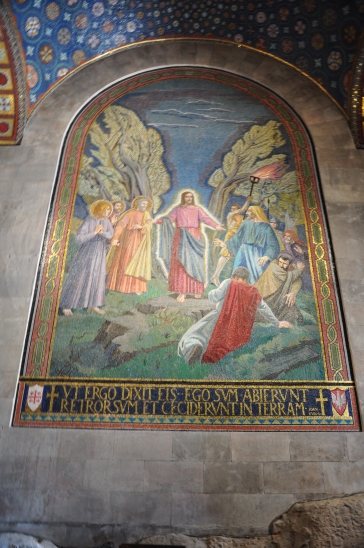
MARY'S TOMB
Church of the Sepulchre of Saint Mary, also Tomb of the Virgin Mary, refers to a Christian tomb in the Kidron Valley at the foot of Mount of Olives, in Jerusalem. It is believed to be the burial place of Mary, the mother of Jesus. Tradition says that the Virgin Mary died a natural death like any human being; that her soul was received by Christ upon death; and that her body was resurrected on the third day of repose, at which time she was taken up, soul and body, into heaven in anticipation of the general resurrection.
THE UPPER ROOM
The "Upper Room," also known as the Cenacle (from Latin cenaculum), is the site of The Last Supper. The "Upper Room" was not only the site of the Last Supper, but the place where the Apostles stayed while in Jerusalem, and was, in effect, the first Christian church. Things other than the Last Supper attributed to this site include: the washing of the feet, several resurrection appearances, the gathering of the disciples after the Ascension, the election of St. Matthias as an apostle, and the descent of the Holy Spirit on the day of Pentecost.
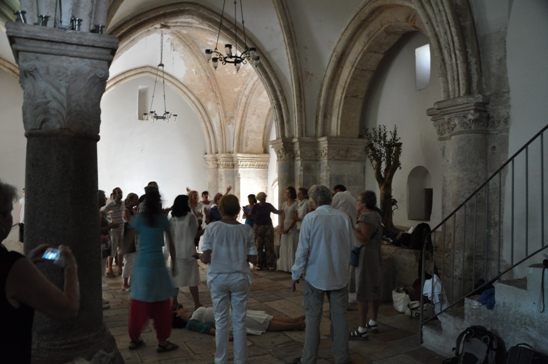
TOMB OF DAVID
King David's Tomb is the burial place of David, King of Israel. It is located on Mount Zion in Jerusalem, near the Hagia Maria Sion Abbey. The tomb is situated in a ground floor corner of the remains of the former Hagia Zion, a Byzantine church. The building is now part of the Diaspora Yeshiva.
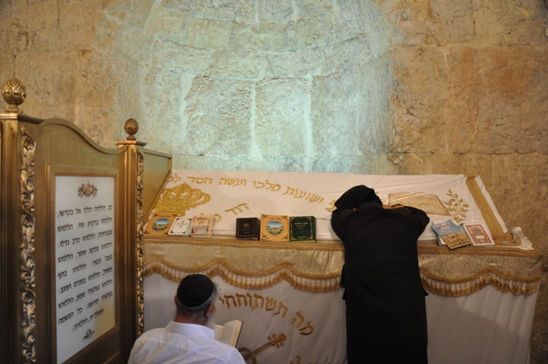
DORMITION ABBEY
Abbey of the Dormition is the home of a Benedictine community in Jerusalem on Mt. Zion just outside the walls of the Old City near the Zion Gate. The community was known as the Hagia Maria Sion Abbey of the Virgin Mary, in reference to the Basilica of Hagia Maria Sion that formerly stood on this site, but resumed the original name during the 2006 100th anniversary celebrations. Hagia Maria Sion is now the name of the foundation supporting the abbey's buildings, community and academic work.
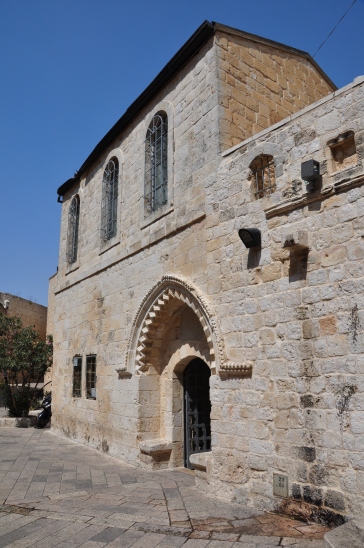
HOUSE OF CAIAPHAS
The House of Caiaphas or Palace of Caiaphas was the place where the High Priest of Israel resided, and it was here that Jesus was examined before the Council in Jerusalem, the Sanhedrin was tried. Peter also denied Jesus in one of the courts of this palace.
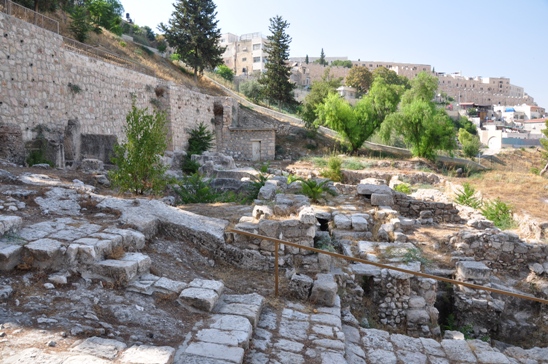
DAY 10: Ein Karem and Bethlehem
On Day Ten, the group went see where it all began, the birthplaces of John the Baptist and Jesus. The beginning of the gospel of Jesus Christ, the Son of God. As it is written in Isaiah the prophet, "Behold, I send my messenger before your face, who will prepare your way, the voice of one crying in the wilderness: 'Prepare the way of the Lord, make his paths straight.'" (St. Mark 1:1-3)
SHEPHERDS' FIELD
Next, the group went to the outskirts of Bethlehem, where on the surrounding hillsides you can still see shepherds tending their flocks. This is where angels came crashing through the heavens to announce the birth of Jesus. (Luke 2:8-20)
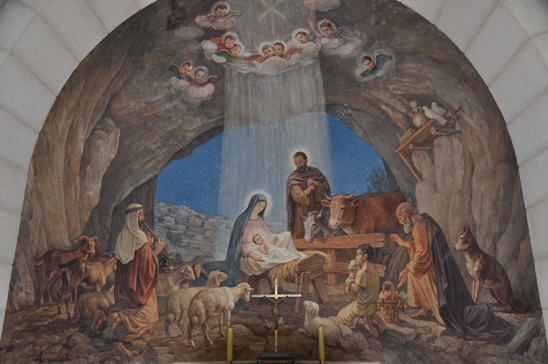
BETHLEHEM AND THE CHURCH OF THE NATIVITY
Next, they went to Bethlehem, the birthplace of Christ. The Church of the Nativity may not be the prettiest church in Christendom, but it has a special beauty. While some of the sites they visited on their tour raised the question, "How do we really know that this is the place where Jesus (fill in the blank)", the site in Bethlehem has the highest authenticity. The Church is built on a cave that the first Christians gathered at, believing it to be the stable where Jesus was born. To this day, shepherds in the Holy Land still use naturally occurring caves as stables to house their animals.
The Church of the Nativity is the oldest church building in the world that has been in continuous operation since its construction. It was built in 565 by Emperor Justinian, having been rebuilt after the Samaritan Revolt of 529. The church before that was commissioned by St. Helena, the wife of Constantine, in 333.
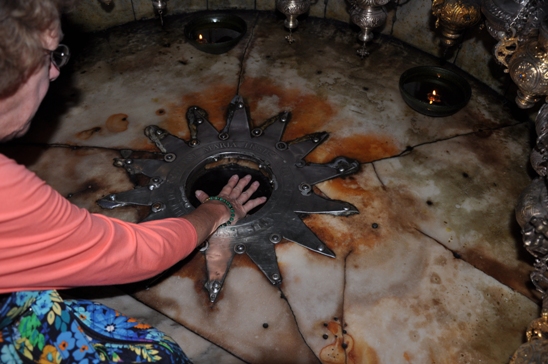
TOMB OF ST. JEROME
St. Jerome established a monastery at the Church of the Nativity and lived there from the years 384 A.D. to 420 A.D. It was there, in a cave off the side of the main church building, that Jerome completed his life work: a translation of the Hebrew and Greek Scriptures into Latin. The Latin Vulgate, as it is called (vulgar meaning the "common tongue"), was the Bible of the West throughout the middle ages, and is still revered in the Roman Church to this day. The group was able to visit the cave of Jerome.
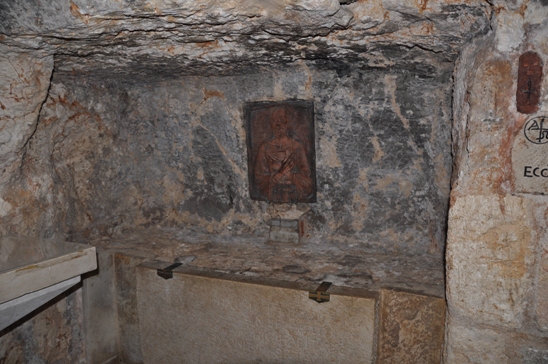
EIN KAREM, MARY'S SPRING AND THE CHURCH OF THE VISITATION
St. Luke writes, "In those days Mary arose and went with haste into the hill country, to a town in Judah..." (Luke 1:39) This town is Ein Karem, where Mary's cousin Elizabeth lived with her husband, Zechariah the priest. It was here, visiting her cousin, that the Blessed Virgin burst out in song, "My soul proclaims the greatness of the Lord"--the Magnificat, recorded in Luke 1:46-55. Ein Karem is also where John the Baptist was born. Since John is the saint after whom St. John's, Dallas, is named, it was a special treat for the group to visit the place of his birth. We prayed Morning Prayer there, reciting the great, Spirit-inspired Song of Zechariah, the Benedictus Dominus Deus, which was uttered by John's father on the occasion of the Forerunner's birth.
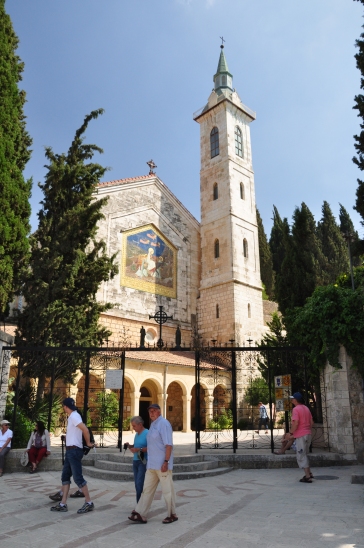
That night the group went back to the Golden Walls Hotel for a festival dinner. Some relaxed and others headed out to Ben Yehuda St. in West Jerusalem for some fun.
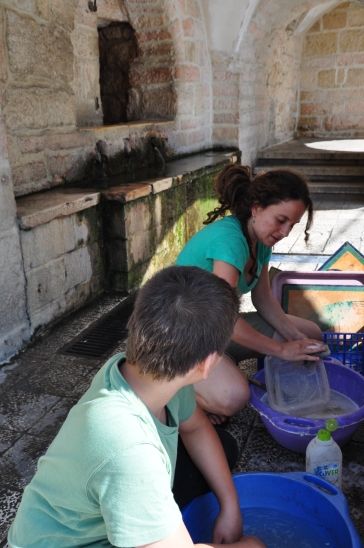
The group had to use their track shoes for a very active day walking the streets of the Old City. They didn't mind the marathon because they knew they would have all night to rest on the plane trip back to the USA.
THE WESTERN WALL AND TUNNEL
Their first stop was the Jewish Quarter and the Western Wall of the Temple Mount. It is called the "Wailing Wall" by many westerners. Apparently the Israelis don't like that name. This is the retaining wall of the Temple Mount, the closest thing the Jewish people have to the Temple that was destroyed by Rome in AD 70. The large stones at the base of the Western Wall go back to the major reinforcements and upgrades Herod the Great made in the first century.
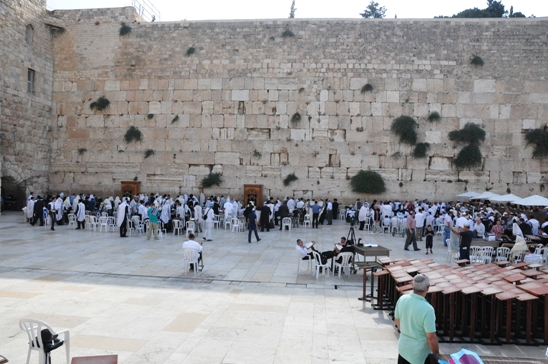
THE TEMPLE MOUNT
Next, they went atop the Temple Mount. The site is still so sacred to orthodox Jews that they will not go there for fear of treading upon the Holy of Holies. This is indeed the place where King Solomon built the first temple around 1,000 BC and where the temple was reconstruction after the Babylonian exile around 516 BC.
Today, the Temple Mount is the site of two shrines that are precious to Islam: El Aqsa mosque, the grey-domed structure to the south of the temple mount, and the Dome of the Rock, the gold domed shrine so often seen in pictures of Jerusalem. The Dome of the Rock stands roughly in the place where Solomon's Temple stood, both being built on Mt. Moriah, the place where Abraham made the near-offering of his son, Isaac.
THE POOL OF BETHESDA
Leaving the Temple Mount they traveled north, to visit beautiful St. Anne's Church, built during the Crusader period, and the Pool of Bethesda. This site is well excavated, and you can see the pools where where Christ healed the lame man in John 5.
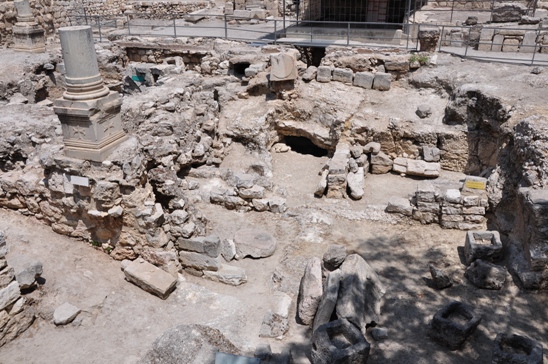
THE VIA DOLOROSA
After lunch, the group followed the steps Christ took to Calvary This is known as the Via Dolorosa or the "Way of Sorrows." They brought copies of the Stations of the Cross and prayed as they went, winding their way to the Church of the Holy Sepulcher.
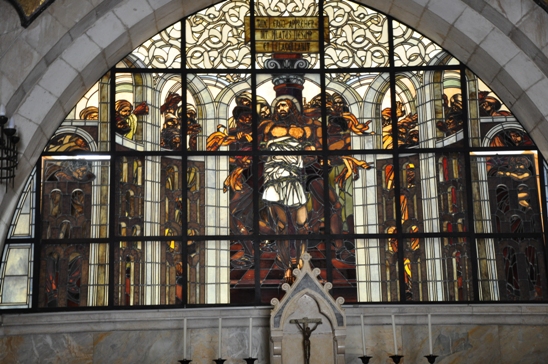
TUNNEL BENEATH THE WESTERN WALL
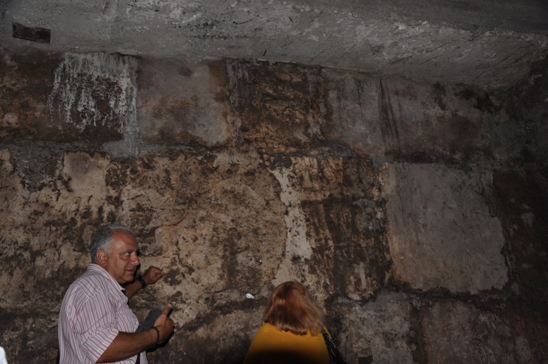
THE LAST SUPPER
That evening, they were treated to a special farewell dinner hosted by Mr. Raji Khouri, the owner of Shepherds Tours, the agency they used in the Holy Land.